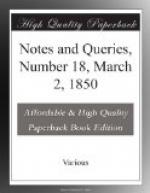Warton and Heinsius.—A late critic thinks he has discovered that Mr. Thomas Warton, a contemporary of Mr. Wise, and fellow of the same college, an antiquary and scholar of whom England may be proud, knew little of Latin, and less of Greek, because, forsooth, he did not notice Milton’s false quantities, which Heinsius did! As well might it be argued, that the critic is an immoral man, because he did not notice the delinquencies of Heinsius in a moral point of view; the said Heinsius being obliged to resign his secretaryship to the city of Amsterdam in consequence of a prosecution by a young woman for breach of promise of marriage, under the faith of which she had lived with him, and borne him two children. The sentence of misdaadigheyd was pronounced against him, and confirmed, on appeal, by the supreme court of Holland, in 1662. So much for the unpatriotic puff of the learned foreigner, to {286} the disparagement of one of the greatest ornaments of English literature. As one “note” naturally produces another, I hope your sense of justice, Mr. Editor, will admit this, in order to counter-balance the effect of the former one; appearing, as it did, in a periodical of considerable circulation, which, I am glad to hear, is soon to be very much improved.
J.I.
Queen’s Bagnio (No. 13. p. 196.).—The Queen’s Bagnio in Long Acre was on the south side, nearly opposite to the door of Long Acre Chapel. The Duke’s bath I have always heard was in Old Belton Street, now Endell Street; the fourth house from Castle Street on the west side. It has been new fronted not long since; but at the time that I frequented the baths there—the exterior had pilasters, and a handsome cornice in the style of Inigo Jones,—all being built in dark red brick. Within there was a large plunging bath, paved and lined with marble, the walls being covered by small tiles of blue and white, in the Dutch fashion. The supply of water was from a well on the premises.
There were several apartments for warm-bathing, having the baths and pavements of marble, and to several of these were attached dressing-rooms.
The house is now, I believe, occupied by a carpenter; but the baths remained, though in a dilapidated condition, a short-time since, and probably are there still.
T.W.
A Flemish Account.—In illustration of a query in your first number on the origin of the expression “a Flemish Account,” unless you think it too late for insertion, I send the following extract from an old volume in the Cathedral Library at Salisbury. It is entitled, “The Accurate Accomptant or London Merchant, &c.; by Thomas Brown, Accomptant: composed for the Use and Benefit of the poor Blew-Coat children educated in Christ’s Hospital, &c. London, printed by William Godbid, sen. 1669. fol.”
The book consists almost entirely of examples of the best methods of keeping accounts, from which I select the following instance:




